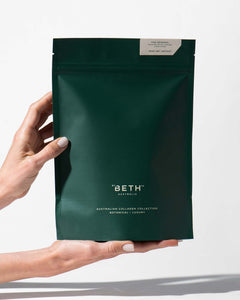
Edible collagen has experienced a massive uptick of late – and with good reason. A super-hydrator for the skin that smooths fine lines and wrinkles, restores bounce and elasticity, and evens out texture, edible collagen has firmly established itself as a beauty essential for anyone wanting to target the signs of ageing, address acne or simply elevate their inner-glow. With so many options to choose from, it can be overwhelming to know where to start. One thing is for sure: not all collagen is created equal, so it’s integral to know exactly where your supplement has come from.
Seeing as edible collagen is absorbed directly into the bloodstream, it’s important to take the highest quality option available to you. Unfortunately, not all brands are forthcoming with this information, making it difficult to ascertain if your supplement is everything it’s promised to be. Here, we’ll take a look at the two main types of collagen – bovine collagen and marine collagen – to explore why source is so essential.
What is marine collagen and where does it come from?
Marine collagen is derived from fish scales and skin. The fish are either caught from the ocean or farmed in fish farms. Both of these present some issues. With the former methods, there is difficulty in regulating the global ocean fishing industry, meaning endangered species may sometimes be caught in the process. Imagine if your collagen came from a shark or jellyfish!
There are also some questions around sustainability with ocean caught fish. The consumer demand for seafood has led to overfishing, which presents a threat to marine life. According to the United Nations, over 80% of the world’s fish species are currently exploited or depleted, while National Geographic reports that if we keep fishing at this pace, our oceans will be devoid of fish by 2048.
Alternatively, marine collagen brands might source their fish from fish farms. It’s difficult to trace the exact origins of where the farms are located (usually in Southeast Asia or China), what species of fish has been used (Tilapia, for example, has large and tough scales so harsh chemicals could have been used in the production process) and the conditions in which the fish were cultivated (various studies point out that hormones, harmful to human health, are often used in the fish farming industry).
This difficulty in tracing the origins of marine collagen also poses the health and safety risk of it being contaminated with heavy metal toxicity and environmental pollutants.
What is bovine collagen and where does it come from?
Bovine collagen is derived from cow hides, bones and muscles. All of By Beth’s bovine collagen is grass-fed, pasture-raised and sourced domestically from a farm within Australia, making it the highest quality edible collagen available. The cattle are managed according to Australia’s strict farming regulations, which ensure they are all deemed fit for human consumption and free from BSE, hormones, antibiotics, toxins and heavy metals. We feel comfortable knowing that we not only have complete visibility over our supply chain but that we are also supporting local farmers.
Bovine collagen also involves less waste and a more efficient production process. As this report points out, bovine collagen is extracted at an 8-20% yield from raw materials, whereas marine collagen is extracted at a 1.2% yield from raw materials.
Which type of collagen, bovine collagen or marine collagen, is the most efficacious?
Bovine collagen has better beautifying benefits than marine collagen. This is for a few reasons. Firstly, it’s more genetically compatible with the human body, meaning it is easily absorbed and distributed throughout the body, including to the dermis (the layer of skin below the epidermis), which boosts the body’s collagen levels. According to experts, marine collagen is non-mammalian and may adversely affect usage in some applications.
Secondly, bovine collagen is rich in both Type I and Type III collagen, whereas marine collagen only contains Type I collagen. Type I collagen minimises fine lines and strengthens skin, nails and hair. Type III collagen provides the added benefits of increasing skin hydration and elasticity, and supporting gut health – which is inextricable to glowing skin. Bovine collagen also has a rich amino acid profile (glycine, proline and hydroxyproline) that promotes healthy, youthful skin.
Finally, bovine collagen is virtually tasteless. While this element doesn’t directly correlate to efficacy, it certainly helps in ensuring edible collagen is something you enjoy drinking and will use daily. Unlike marine collagen, which tends to have a fishy taste, bovine collagen is neutral on the palate and blends beautifully into your favourite hot or cold liquids, as well as combining with sweet and savoury recipes.
Explore the By Beth range of 100% Australian bovine collagen



